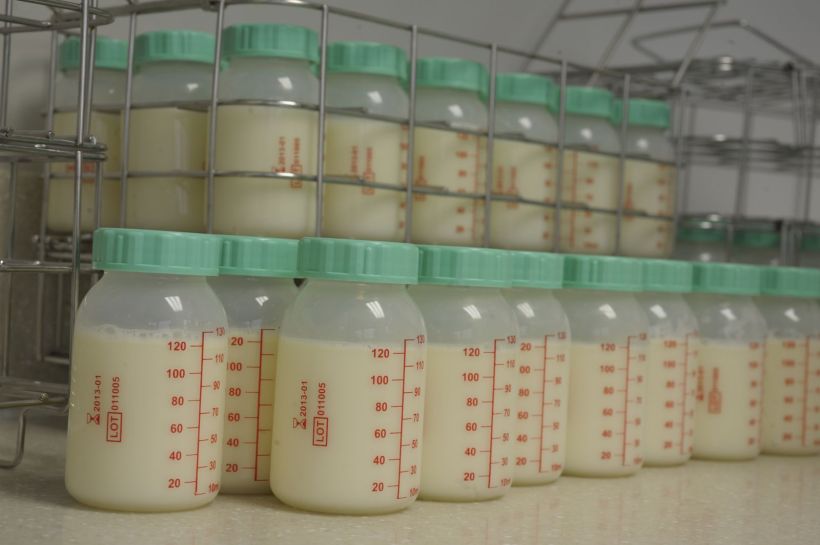In the neonatal intensive care unit, human milk is preferred food for preterm and very preterm infants. The American Academy of Pediatrics has recommended that very preterm infants especially receive human milk – ideally from their mother, but in the absence of her milk, from donor milk. For very premature infants (less than 30 weeks), it is well established that human milk reduces the risk of necrotizing enterocolitis (NEC), a bacterial infection of the intestines with devasting consequences, and is associated with improved growth, cognitive development, and survival compared to infants receiving formula. Many different components of human milk – such as epidermal growth factor – have been hypothesized to contribute to this generalized protection of premature infants by human milk. More recently, there has been a growing appreciation for the microbiome of human milk as part of this protective-developmental compliment of human milk. Milk microbiomes are highly variable between mothers (more than 200 different species have been identified) although nine main groupings are found in almost all samples (Hunt et al., 2011).
There’s just one problem: donor milk, used when an premature infant’s mother’s own milk (MOM) is not available, generally consists of pooled and pasteurized milk from several donors. The process of pasteurization kills the bacteria in milk and thus removes one of the potential bioactive portions of human milk that may be protective against NEC (it also likely inactivates other bioactive molecules too). Donor milk – the second best food for premature infants after milk from the infant’s own mother – is suddenly missing one OR MORE of the factors in human milk that is thought to protect against NEC and other gastrointestinal infections.
But what would happen if you incubated donor milk with unpasteurized milk, from the infant’s own mother? Would a small volume of living, unpasteurized milk from the infant’s mother be enough to colonialize the milk sample – and the infant’s guts – with the mother’s own milk microbiome? How amazing would that be – an infant could receive the quantity of donor milk and the microbiome of their own mother!
A recent paper by Cacho et al., (2017) did just that. Twelve infants, weighing less than 3.3 pounds at birth and less than 32 weeks gestation and their mothers were recruited into the study. Mothers were producing more than 100 mL/3.3 ounces of milk per day but not enough milk that the infant did not also need donor milk. The mothers each provided one 45mL sample of milk. In order to determine the amount of mother’s milk to donor milk that might be necessary to inoculate the donor milk with the mother’s microbiome, mother’s milk was added to donor milk as a percentage of total volume: 1% mother’s milk/99% donor; 5% MOM/95% donor, 10% MOM/donor, and 30% MOM/donor. Milk mixtures were then incubated at body temperature and samples were collected at 0, 4, and 8 hours after mixing. Both DNA and bacterial cultures were used to measure the microbiome of the milk samples.
In all samples, many of the bacterial microbiome identified in MOM’s milk at baseline were detectable within 8 hours, even in the 1% MOM/99% donor group! The researchers concluded that the 10% MOM/90% donor group, incubated for four hours, was the closest match in type diversity and bacterial number to the infant’s mother’s own milk. The 1% and 5% groups, after 8 hours, did show profiles approaching the mother’s own profile but still had lower counts. By comparison, the 30% sample had higher counts than the mother’s milk. There was no consistent microbiome pattern in the study – each mother had a unique milk microbiome profile. However, there was clustering: breast milk microbiomes clustered by delivery type, with mothers who had vaginal deliveries having higher numbers of bacteria from the groups Halomonas, Lactobacillus, Prevotella, and Ruminococus and mothers who had caesarian sections having more bacteria from the groups Erwinia and Pseudomonas.
In summary – the addition of just a small amount of a mother’s own milk to pasteurized donor milk for a few hours is enough for her milk microbiome to increase and colonize the milk sample. The mother’s microbiome – reflecting her own ecological history, genetics, and likely the prenatal microbiomes the infant encountered, can be provided to her infant. The mother’s unique microbiome is returned to the milk received by her infant – and likely has all the long-term benefits of her microbiome for her infant.
References
Cacho NT, Harrison NA, Parker LA, Padgett KA, Lemas DJ, Marcial GE, Li N, Carr LE, Neu J, Lorca GL. (2017) Personalization of the Microbiota of Donor Human Milk with Mother’s Own Milk. Front Microbiol. 3;8:1470. doi: 10.3389/fmicb.2017.01470.
Hunt KM, Foster JA, Forney LJ, Schütte UM, Beck DL, Abdo Z, Fox LK, Williams JE, McGuire MK, McGuire MA. (2011) Characterization of the diversity and temporal stability of bacterial communities in human milk. PLoS One 6(6):e21313.

When I was completing my graduate degree at the University of Pittsburgh in 1972, my wife and I used every stratagem we could think of to pare expenses.
One of the more obvious approaches to fresh yogurt consumption was to make our own. This was no more complex than buying whole cow’s milk together with the smallest retail container of yogurt available. A couple teaspoons of yogurt into a quart of cow’s milk, sitting overnight on the pilot light of our gas cooker, and we had ample amounts of a favorite food.
I recall this quintessential impecunious student moment in the light of reading this short but fascinating post, which somehow seems terribly obvious after the fact. Thank you for including it here.
James Akre
Geneva, Switzerland
LikeLiked by 1 person